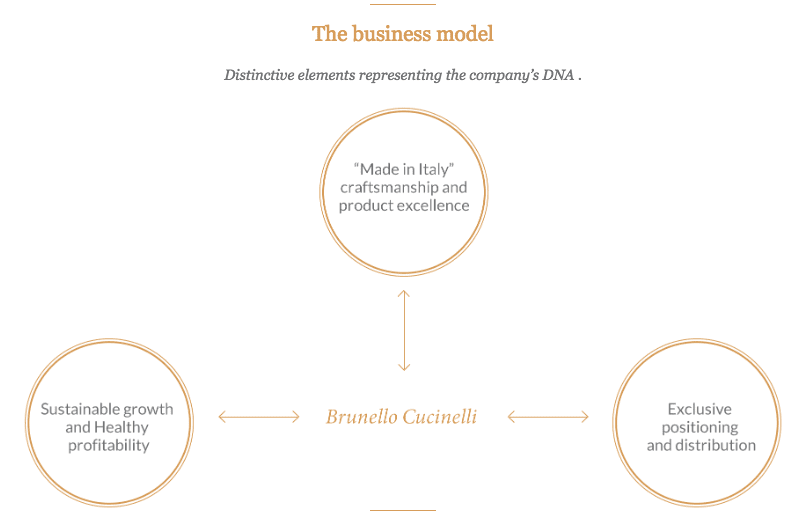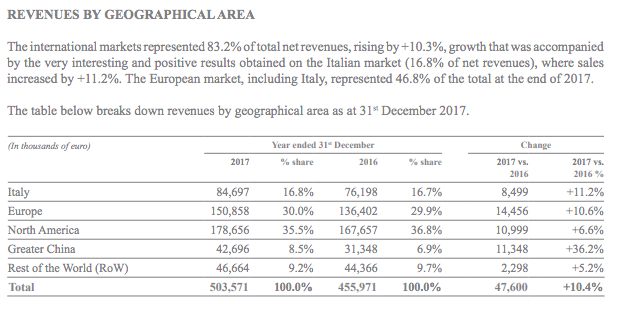| Not logged in : Login |
About: Brunello Cucinelli: The Humanistic Enterprise Business Model Goto Sponge NotDistinct Permalink

Brunello Cucinelli is an Italian luxury and casual-chic brand, which built its success around cashmere clothing. Brunello Cucinelli built its business around the Humanistic Enterprise model which revolves on Italian Craftsmanship, Sustainable Growth, and Exclusive Positioning and Distribution. The company made over €503 million in 2017, mainly driven by its retail channel, which represented 53.7% of its revenues. Italy, Europe, and North America represent the largest markets for Brunello Cucinelli. Brunello Cucinelli: the Philosopher turned Entrepreneur Brunello Cucinelli is more of a philosopher than an entrepreneur. When I met him I was surprised by his sharpness of thought, which I suspected came from a sort of life/philosophical framework he had developed throughout his life. I then found out that framework was built around philosophers and men of actions, like Socrates, Alexander the Great Marcus Aurelius and Saint Benedict, If at all, Cucinelli started his entrepreneurial journey with a mission: to preserve and improve human life via craftmanship. Therefore, his attempt to build a company based on those principles is more of a way to show to the world that philosophy is a critical thinking tool. Just like the ancient philosopher, Thales (about 2,600 years ago) showed to the world he could make a lot of money with his philosophy. Brunello Cucinelli will probably be remembered as the modern version of a philosopher turned entrepreneur. This is not to say that philosophy should be looked at with a utilitarian view. Quite the opposite, whatever road you decide to take philosophy might be a powerful thinking tool that will be worth developing independently from the financial returns it might give you in the real world. Let's look at the Brunello Cucinelli Empire. Brunello Cucinelli Humanistic Enterprise In 1978 Brunello Cucinelli started as a cashmere producer. Today Cucinelli is among the most established brands in the luxury and casual-chic brands. The main focus of Cucinelli is on the hand-crafted attention to detail and creativity. The center of the Humanistic Enterprise is the small town of Solomeo, the 14th-century hamlet outside Perugia, home to 400 inhabitants. The company headquartered in a castle is surrounded by a few medieval houses used as workshops. Just like Google has built its innovations labs around the Googleplex, Cucinelli has developed its success around the small medieval town of Solomeo. Brunello Cucinelli mission and its code of ethics As highlighted on Brunello Cucinelli website: I believe in a humanistic enterprise: business should comply in the noblest manner with all the rules of ethics that man has devised over the centuries. I dream about a form of humanistic modern capitalism with strong ancient roots, where profit is made without harm or offence to anyone, and part of it is set aside for any initiative that can really improve the condition of human life: services, schools, places of worship and cultural heritage. This mission revolves around a few simple principles in its code of ethics: Legality In conducting its business, the Company acts in a manner compliant with all laws and regulations in force in the territories in which it operates, as well as with the Code of Ethics and Company procedures, which it applies with integrity and equity. Confidentiality The Company guarantees the confidentiality of the personal information and data it processes and the protection of information obtained in regards to professional services rendered. Transparency The Company undertakes to provide all stakeholders with a clear and transparent account of its situation and performance, without favouring any group of interests or individual. Fair competition The Company operates on the Italian and international market in the sale of cashmere knitwear, articles of apparel in leather and other materials, and accessories, and engages in fair competition in the marketplace, complying with Italian and European principles and laws protecting competition. Personal dignity The Company undertakes to promote respect for the physical and cultural integrity of individuals and respect for interpersonal relations. It guarantees working conditions that are respectful of individual dignity and safe working environments and safeguards and promotes the value of human resources, all with the aim of improving and increasing the wealth of skills possessed by each employee. Integrity and propriety Dealings with the Company's stakeholders are guided by the principles of propriety, cooperation, loyalty and mutual respect. External relations and employee relations are shaped by the utmost sense of loyalty, which consists in acting with a sense of responsibility. Quality The Company undertakes to be attentive to the market's changing needs and to constantly improve the quality of its products. Environmental protection The Company contributes constructively to environmental sustainability in all of its activities. The commitment to safeguard the environment is put into practice by planning activities that seek a balance between economic initiatives and essential environmental needs in accordance with applicable Italian and international directives. Responsibility to society In its operations, the Company takes account of the needs of the community in which it conducts its business and contributes to promoting quality of life as well as economic, social, cultural and civil development. Brunello Cucinelli corporate structure Source: Brunello Cucinelli annual report for 2017 Brunello Cucinelli S.p.A. is the holding that controls all the other companies spread across the world. Other subsidiaries, like Brunello Cucinelli S.r.l., and Brunello Cucinelli USA Inc. control the companies operating in each country and geographical area. Brunello Cucinelli distribution strategy Cucinelli has a diversified distribution strategy based on three main channels: Retail distribution channel: or direct distribution channel, via the directly operated stores (DOS). In certain countries, local operators also have an interest in the Group company running the DOS, to align interests and share their market experience. Wholesale monobrand channel: it consists primarily of monobrand stores operated under commercial distribution agreements. Wholesale multibrand channel: consisting of independent multibrand stores and dedicated spaces within department stores (shop in shop). What are Brunello Cucinelli distinctive traits? Cucinelli brand positioning If there are a few words that define Brunello Cucinelli brand, those can be summarized in five main words, adjectives and one action: craftsmanship, creativity, exclusivity, beauty, and a remarkable desire to “listen to” the market and its new trends Those traits together contribute to the long-term vision of Cucinelli growth. What financial metrics does Cucinelli use to assess its business success? Once you have down the mission, vision and the main traits of your brand. It is critical to have a few financial metrics to be able to assess at quantitative level how the business growth is progressing. For that matter, as indicated within the Cucinelli annual report, those metrics are summarized below: EBITDA: operating profit before depreciation, amortization and impairment. Net Working Capital: the sum of inventories and trade receivables less trade payables and the net balance (asset or liability) of all the other balance sheet items classified as current assets or current liabilities. Commercial Working Capital: the sum of inventories and trade receivables less trade payables. Net Invested Capital: the sum of non-current assets and current assets, excluding financial assets (other current financial assets and cash and cash equivalents), less non-current liabilities and current liabilities, excluding financial liabilities (current and non-current bank debt, current and non-current financial payables). Net Debt: the sum of current and non-current bank debt and current and non-current financial payables including the fair value (positive or negative) of hedging derivatives on loans, excluding cash and cash equivalents and other current financial assets, including the fair value (positive or negative) of hedging derivatives on loans. Capex: capital expenditures refer to gross investments in intangible assets, property, plant and equipment, and net investments in financial assets. Brunello Cucinelli business model Source: investor.brunellocucinelli.com/en/business-model/the-business-model Brunello Cucinelli business model revolves around three distinctive elements that make up for the company's DNA. It all starts from the Italian Craftmanship, intended as "Manufacture through highly specialized artisanal laboratories, all of which are based in Italy, and most are located very close to the company in Umbria." In a global economy that has stressed so much outsourcing and lowering the cost of manufacturing to countries like China and India, to reduce the cost of production, Cucinelli has built an alternative model. This model is built on sustainable growth (profits and people come together) and an exclusive positioning (top end of the luxury segment) and distribution strategy (based on mono-brand boutiques in the main luxury streets and to prestigious multi-brand boutiques and Luxury Department Stores). Brunello Cucinelli in numbers Source: Cucinelli Financials 2017 With over €500 million in sales in 2017, Cucinelli makes money via three main distribution segments (Retail, Wholesale Monobrand, Wholesale Multibrand). Retail represented 53.7% of total revenues in 2017, compared to Wholesale Monobrand with 5% of the revenues, and Wholesale Multibrand at 41.3%. At geographical level, the most significant countries were: Italy which represented 16.8% of its revenues in 2017, North America which represented 35.5% of its revenues and China, which represented 8.5% of its revenues. Other handpicked related articles: What Is a Business Model? 30 Successful Types of Business Models You Need to Know How Does PayPal Make Money? The PayPal Mafia Business Model Explained How Does WhatsApp Make Money? WhatsApp Business Model Explained How Does Google Make Money? It’s Not Just Advertising! How Does Facebook Make Money? Facebook Hidden Revenue Business Model Explained Marketing vs. Sales: How to Use Sales Processes to Grow Your Business The Google of China: Baidu Business Model In A Nutshell Accenture Business Model In A Nutshell Salesforce: The Multi-Billion Dollar Subscription-Based CRM How Does Twitter Make Money? Twitter Business Model In A Nutshell How Does DuckDuckGo Make Money? DuckDuckGo Business Model Explained How Amazon Makes Money: Amazon Business Model in a Nutshell How Does Netflix Make Money? Netflix Business Model Explained
| Attributes | Values |
|---|---|
| type | |
| label |
|
| label |
|
| sameAs | |
| Description |
|
| depiction | |
| name |
|
| url |
|
| founder | |
| legalName |
|
| http://www.w3.org/2007/ont/link#uri |
Alternative Linked Data Documents: PivotViewer | iSPARQL | ODE Content Formats:
![[cxml]](/fct/images/cxml_doc.png)
![[csv]](/fct/images/csv_doc.png) RDF
RDF
![[text]](/fct/images/ntriples_doc.png)
![[turtle]](/fct/images/n3turtle_doc.png)
![[ld+json]](/fct/images/jsonld_doc.png)
![[rdf+json]](/fct/images/json_doc.png)
![[rdf+xml]](/fct/images/xml_doc.png) ODATA
ODATA
![[atom+xml]](/fct/images/atom_doc.png)
![[odata+json]](/fct/images/json_doc.png) Microdata
Microdata
![[microdata+json]](/fct/images/json_doc.png)
![[html]](/fct/images/html_doc.png) About
About


![[RDF Data]](/fct/images/sw-rdf-blue.png)
OpenLink Virtuoso version 08.03.3330 as of Mar 11 2024, on Linux (x86_64-generic-linux-glibc25), Single-Server Edition (7 GB total memory, 6 GB memory in use)
Data on this page belongs to its respective rights holders.
Virtuoso Faceted Browser Copyright © 2009-2024 OpenLink Software






